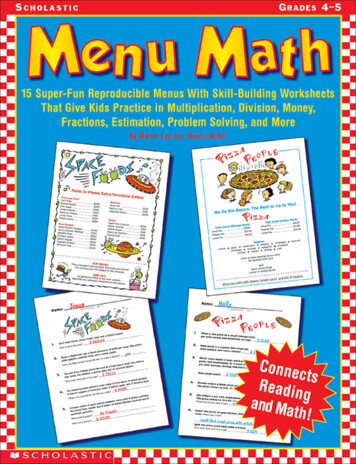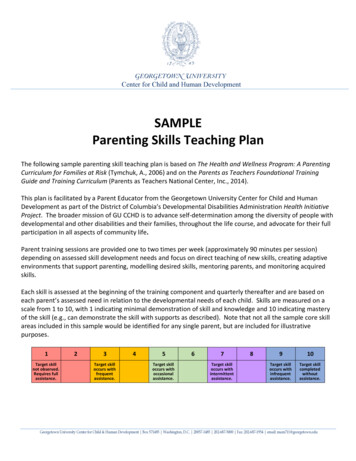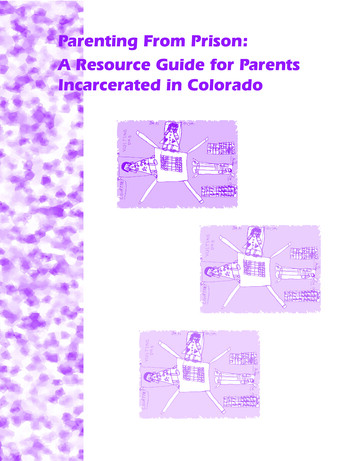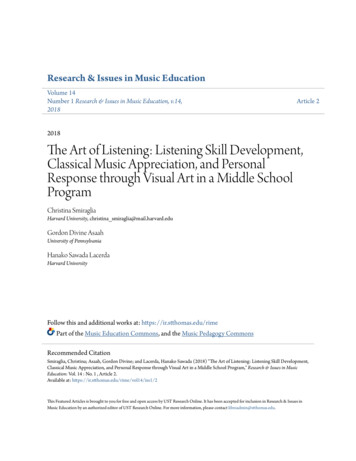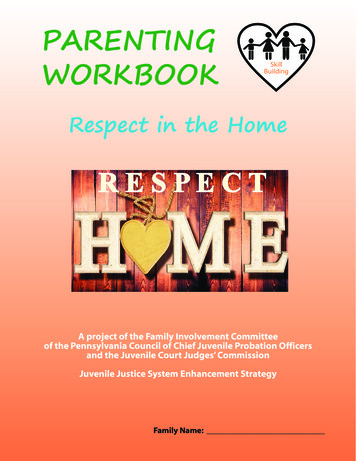
Transcription
PARENTINGWORKBOOKSkillBuildingRespect in the HomeRESPECTA project of the Family Involvement Committeeof the Pennsylvania Council of Chief Juvenile Probation Officersand the Juvenile Court Judges’ CommissionJuvenile Justice System Enhancement StrategyFamily Name:
The preparation of this document was supported by sub-grants (2013/15-J-0227488 and 2015/16/17-J-04-28369) awarded to the Pennsylvania Council ofChief Juvenile Probation Officers from the Pennsylvania Commission on Crimeand Delinquency (PCCD). The awarded funds from PCCD originated with theOffice of Justice Programs, U.S. Department of Justice, Office of Juvenile Justiceand Delinquency Prevention. These materials are considered public domain.Points of view or opinions contained within this document are those of theauthor(s) and do not necessarily represent any official position, policy or view ofthe Pennsylvania Commission on Crime and Delinquency or the U.S. Departmentof Justice.Published 2019
ParentingWorkbookRespect in the HomeINTRODUCTIONRespect is a core human value. It is especially important that it be present in our homesamong family members. Home should be a safe place—physically, emotionally, andspiritually. It should be a place where harmony abounds and where family membersknow they are valued and supported.Respect is shown through both words and actions. Respectful words are spoken in acaring tone, are non-blaming, and stir up feelings of warmth and love. Respectful actionsare demonstrated when family members honor one another, respect one another'spossessions, and help those in need—even at personal sacrifice.To create a home environment where family members demonstrate androle model respect for each other and where they feel supported, heard,and affirmed.TABLE OF CONTENTSPart A: Why Does My Child Sometimes Act Disrespectfully?Understanding your child’s brain development?Features of respect?Activity: Most important features of respect?Assignment: Look in the pastPart B: What Respect Looks Like?Modeling respect?Five principles for respect?Assignment: Identify when respect or disrespect occurred in the homePart C: How Are We Doing?Activity: Role modeling in the home?Getting respect back: A three-step process?Assignment: Develop a plan to discuss with your child how to win back respect(or alternative assignment on logging respectful and disrespectful behavior)Part D: The Role of Listening in Respect?Examples of not listening actively?Activity: Phrases to help us listen actively?Activity: Choose active listening phrases?Assignment: Use active listening in a conversation with your childIntroductionPage 1 of 2
ParentingWorkbookRespect in the HomeRESPECT IN THE HOME SURVEY (PRE-ASSESSMENT)For each statement, circle the number that best describes your experience.A.I/we demonstrate respect to my/our child in the arely2Sometimes3Often4Always5I/we listen to my/our child in a way that makes my/our child feel heardNever1E.Often4I/we routinely serve as a role model by showing respect for othersNever1D.Sometimes3I/we receive respect from my/our child in the /we are fully present–physically and emotionally–when spending time withmy/our ys5Page 2 of 2
ParentingWorkbookRespect in the HomeQUICK TIPS CARDSFeatures of Respect?Exhibit good manners, politeness,courtesyEffective Communication Tips?Take turns speaking and listening?Use active listening skills?Show empathy by listening to feelings?Allow silence when appropriate?Make sure to spend time with each?Ask open-ended questions (questions thatother?Appreciate accomplishments?Value each other's opinions?Consult with family members impactedby a decision?Give opportunities to make mistakesand learn from them?Take an active interest in each other’sactivities and goalsrequire more than a one- or two-wordreply)?Reflect back to the speaker what youthought you heard them say?Clarify misunderstandings by askingfurther questions?If you have feedback to share, first ask theperson if they are open to hearing yourthoughts?Provide feedback objectively?Listen without judgment?Refrain from making assumptions?Refrain from multi-tasking?Respect autonomy?Establish your boundaries in a firm butneutral way5 Guidelines That DefineRespectful Actions1. Recognize that every life has equalvalue2. Demonstrate sensitivity3. Respect diversity4. Allow choices5. Be fully presentQuick Tips3 Steps to Restoring Respect1. Assess the level of reduced respectand refer to counseling if needed2. Apologize for times you have fallenshort3. Develop a plan to discuss with yourchild what respect looks like and howyou are going to act going forwardPage 1 of 1
Page IntentionallyLeft Blank
ParentingWorkbookRespect in the HomePart A: Why Does My ChildSometimes Act Disrespectfully?At its root, mutual respect means honoring and treatingeach other with care, warmth, and courtesy. It meansrecognizing that every person–both inside and outsidethe home–is worthy of being treated with dignity. Alack of respect may have been a factor in your child'sinvolvement in the juvenile justice system.You may have been frustrated with your child’s disrespectful behavior. Think about a timeyour child was disrespectful and circle up to 3 feelings you experienced.AfraidConfusedMixed edDiscouragedBlueDisappointedEmbarrassedGuiltyLeft ustedFed ndedRagefulProvided with permission from Carey Group PublishingPart A: Why Does My Child Sometimes Act Disrespectfully?Page 1 of 6
ParentingWorkbookFRONTAL LOBERespect in the HomePARIETAL LOBEOCCIPITALLOBETEMPORALLOBEBrain Development. Adolescent behavior isinfluenced by physical changes in the body,including in the brain. These changes caninfluence how youth respond to conventionalrules around respect. Caregivers may be leftwondering how their child could act so rudely,especially when they were not raised that way.CEREBELLUMOur growing knowledge of brain developmentteaches us that adolescents have limited capacityfor self-regulation, making it more likely that theywill say or act in disrespectful ways, especiallywhen faced with an emotionally charged situation.It is more difficult for them to think about consequences, or to examine the pros andcons of an action, before acting. Youth are also prone to misinterpreting social cues. Thecombined effect is an increase in impulsive and disrespectful acts. Furthermore, becausethey are preparing for independence, they tend to push back at the status quo, whichresults in what appears to be a disrespect for rules and authority.BRAIN STEMLook at the illustration below. Answer the questions that follow based on yourunderstanding of brain development.22Late adolescenceWhere amI going?2120- Improved delayed gratification- Improved concern for others- Greater ability to compromise- Greater emotional stability- Improved self-regulation1918Middle adolescenceWho amI?1716- Some drift to poor self-concept- Desire for more independence- Lower opinion of parents; withdrawal- Strong emphasis on peer group15Early adolescence1413Am Inormal?1211- Struggle with sense of identity- Moodiness- Increase in rude behavior- Return to some childish behaviors- More influence from peers- Pushing limits and rules- Greater interest in privacyPart A: Why Does My Child Sometimes Act Disrespectfully?Page 2 of 6
ParentingWorkbookRespect in the HomeBased on your child’s age, what does brain science tell you about how your child may view relationships? how your child may view rules? your child's inclination to act respectfully?Some time ago, your child may have been given an assessment interview by someonein the justice system. This assessment collected information about your child, includingfactors that influence the likelihood of them getting caught up in the justice system again.A couple assessment factors related to respect are a lack of empathy toward others and alack of respect for authority. These factors can lead to behavioral problems in school, athome, and in the community.Fortunately, these factors can be changed. Not only does teaching respectful behaviorhelp our loved ones stay out of legal trouble but it helps make everything run moresmoothly and be more pleasant.In the table on the next page are some features of respect and an example of whateach feature looks like. Select the three features that are most important to you. Then,write about a time when you, your child, or another family member displayed thosefeatures.Part A: Why Does My Child Sometimes Act Disrespectfully?Page 3 of 6
ParentingWorkbookFeatures ofrespectRespect in the HomeExample3 mostimportantDescribe a time you, yourchild, or another familymember displayed thisüGood manners,politeness, courtesyA child helping carry thegroceries into the housewithout being askedShowing empathyby listening tofeelingsA parent listening tohow angry their child isbecause of how theirteacher treated theminstead of trying tochange how their childfeelsTaking time tospend with eachotherA child choosing tospend time with theirfamily instead of withtheir friendsAppreciatingaccomplishmentsA parent making aspecial meal when theirchild attends all classesfor the entire semesterValuing each other'sopinionsOne spouse tellingthe other that theyappreciate their view ofsomething even thoughthey have a differentviewPart A: Why Does My Child Sometimes Act Disrespectfully?Page 4 of 6
ParentingWorkbookFeatures ofrespectRespect in the HomeExample3 mostimportantDescribe a time you, yourchild, or another familymember displayed thisüConsulting withfamily membersimpacted by adecisionParents talking withchildren about movingto a new apartmentbefore deciding to moveGiving opportunities A parent letting theirchild go to their firstto make mistakesand learn from them party at age 16 aftergoing over the rulesand expectationsTaking an activeinterest in eachother’s activitiesand goalsFamily members askingone another at dinnerhow their day wasOther (fill in)Part A: Why Does My Child Sometimes Act Disrespectfully?Page 5 of 6
ParentingWorkbooktnemnA s s igRespect in the HomeBy understanding childhood development, we can respond withless negative emotion when our child acts disrespectfully. Wecan be more sympathetic when we realize that their brain isstill developing and that more mature behaviors, such asdemonstrating patience, truly listening, showing pride in others’accomplishments, and exhibiting empathy, will occur morefrequently as they grow older. It might help to reflect on yourteenage years, when your brain was similarly developing.List up to three ways that you acted disrespectfullywhen you were a teenager. (If you don’t rememberand your caregivers are available, ask them.)Examples ofdisrepectfulteenage behavior:1.Being rude2.3.Rolling eyesMaking fun of othersRunning away from homeCalling namesIf neither you nor your caregivers can provideexamples of your disrespectful behavior as ateenager, invite a couple of friends to shareexamples of what they did.1.Refusing to speakStealingSlamming doorsThrowing objectsMaking insensitive comments2.3.Criticizing others harshlySwearingDemandingPart A: Why Does My Child Sometimes Act Disrespectfully?Page 6 of 6
ParentingWorkbookRev iewRespect in the HomeAssignment Review: Answer the following questions about yourdisrespectful behavior as a teenager (or the disrespectful behaviorof those you interviewed):How old were you (or those you interviewed) when the disrespectful behavior was at itsworst?At what age did your disrespectful behavior (or the disrespectful behavior of those youinterviewed) begin to change for the better?How was your disrespectful behavior as a teenager (or the disrespectful behavior of thoseyou interviewed) the same as or different than that of your child?What does this assignment make you think about regarding your child’s disrespectfulbehavior?Part B: What Respect Looks LikeHome is theincubatorfor respectPart B: What Respect Looks LikeYou may have heard the phrase "Home is theincubator." What exactly does that mean? As we areusing it here, it means that our values and behavior arelearned by observing and imitating others, especiallythose we admire. Given the amount of time we spendwith family and the importance of family relationships,it makes sense that we learn respect through our homelife.Page 1 of 8
ParentingWorkbookRespect in the HomeThere are many ways to teach our childrespect. One way is to model respectfulbehavior. Another way is to reinforce ourchild’s respectful behavior, for example, byshowing gratitude when they help out. Athird way is to respond appropriately to theirnegative behavior, for example, by givingthem a time-out when they hit, scream, orinterrupt.Look over the list of statements (in green)and behaviors (in blue). Circle the ones thatyou feel are most disrespectful.Definition of FamilyA family consists of two or moreindividuals who share a sense ofidentity and provide each otherwith support through sharedvalues and beliefs, sharedtraditions, activities done together,unconditional love, and holdingone another accountable. The gluethat holds these elementstogether is love and respect.tooing ntswrong”gt“You areNo ly eve“ianyth You don’tfaming; ykTalking back to a teacherou’re nowonly 15”peoplerlaupopnuoringnIgtoinuoyt“I broughRold I canl in gthis world an t”“I givsououoyeme youreketahandup; Ihtone eyelcegan’tthis allinis t s whneytlohalkn g er ”ing enNot trutTailgating someone whenthey are driving too slowlyte”ays lawlaare“YouLeaving dirty dishesin the living roomure yoyou’llnoea peer whon and ut”ifoanmgfuaogtninMakgstiohealth alk like tha h knocked oivin attens a mentala“Tghtlur teetNofulconditionget yofamilyCuttinaring a lotheseg in liW“He only cares’s cmovie ne at thmember asking firsteabout himself”theattuerwithoThink about the items you circled. What makes them disrespectful? List three themes(e.g., they do not consider other people's feelings, they do not respect personal privacyor property).1.2.3.Part B: What Respect Looks LikePage 2 of 8
ParentingWorkbookRespect in the HomeIn the same way, look over the list of statements (in green) and behaviors (in blue).Put a check mark next to the ones that you feel are most respectful.“That is not the way I see it, but I can understand why you say that”Asking a family member if they need help with a choreSpending time with one’s grandmother when she visits“Maybe I did not explain it very well”“Tell me more; I am not sure that I understand”Looking someone in the eye when talking“It hurts me when you talk that way”Taking care of the family petNot talking back to people in authority“I’m sorry you are feeling so upset”Giving the elderly your seat on the busBeing on timeSharing what is yours“I’m sorry; I was wrong”Think about the items you checked. What makes them respectful? List two themes(e.g., they use polite language; they show that you value others).1.2.Part B: What Respect Looks LikePage 3 of 8
ParentingWorkbookRespect in the HomeThere are five principles that help us know if words or actions are respectful. Let's look atthe principles one at a time and answer the question that follows each one.RecognizingThat Every LifeHasEqual ValueBeing yRespectingDiversity1. Recognizing that every life has equal value. We show people that we considerthem equals when we speak with them, not at them; recognize that their needsare as important as ours; and acknowledge that our timeline is not their timeline.Treating people as equals means not putting them down, not gossiping aboutthem, and not pushing our way on them.Example when this principle is violated: When Maria's sister mocks theirneighbors, calling them “trailer trash.”How should Maria have responded if she believed in this principle?Part B: What Respect Looks LikePage 4 of 8
ParentingWorkbookRespect in the Home2. Demonstrating sensitivity. We demonstrate sensitivity when we have empathy foranother person, recognize the importance of their wants and feelings, respect theirprivate property and personal space, and avoid saying/doing things that are hurtfulor that make them feel defensive.Example when this principle is violated: When Brian wants something, heinterrupts his mother when she is on the phone.What should Brian have done if he believed in this principle?3. Respecting diversity. We respect diversity when we value other people’s opinionseven when we may not agree with them, accept that we may not always be right,seek to understand instead of to criticize, and choose not to judge other people’sintentions or assume the worst.Example when this principle is violated: When Jordan disagrees with his mother,she gets angry and tells him that he is too young to have an opinion.What should Jordan's mother have done if she believed in this principle?4. Allowing choices. Allowing choices means valuing other people’s independenceand right to choose, accepting their ways of doing things rather than forcing themto act in a certain way, and acknowledging the importance of them makingmistakes and learning from them.Example when this principle is violated: When Aliyah tells Terrell about her plansto buy a car, Terrell rolls his eyes and walks away.What should Terrell have done if he believed in this principle?Part B: What Respect Looks LikePage 5 of 8
ParentingWorkbookRespect in the Home5. Being fully present. Being fully present means listening actively, using bodylanguage that shows engagement (such as nodding, smiling, or speaking in asupportive tone), ignoring distractions, and focusing on the person rather thanon multiple other tasks.Example when this principle is violated: Taylor watches TV all day. When hiscaregiver wants to talk, he keeps watching TV and does not look up.What should Taylor have done if he believed in this principle?Here are other behaviors that are not respectful. Which principle does each behaviorviolate? (Hint: There may be more than one correct answer.)- Matt's father dominates family conversations, not giving anyone else a chance to talk.- When Hailey’s extended family gets together on holidays, Hailey spends most of thetime talking on the phone with her friends.- Tiana refuses to let her daughter pick out her school clothes and insists that she wearonly what she puts out for her.- Kayla treats Alika poorly because she “has weird customs” and wears “ethnic clothes.”- Nancy and her friend talk loudly in the movie theater.Part B: What Respect Looks LikePage 6 of 8
ParentingWorkbooktnemnA s s igRespect in the HomeWe sometimes focus too much on the negative and we are notalways aware of how often we actually do demonstrate respect foreach other. Think back over recent months and identify three timesyou showed respect to your child and three times your child showedrespect to you or others. Do the same with disrespectful behaviors.Three times in the past few months whenI showed respect to my child:Three times in the past few months whenmy child showed respect to me/others:1.1.2.2.3.3.Part B: What Respect Looks LikePage 7 of 8
ParentingWorkbookRespect in the HomeThree times in the past few months whenI showed disrespect to my child:Three times in the past few months whenmy child showed disrespect to me/others:1.1.2.2.3.3.Part B: What Respect Looks LikePage 8 of 8
ParentingWorkbookRev iewRespect in the HomeAssignment Review: Look over the list of times you demonstratedrespect to your child and your child demonstrated respect to you orothers.1. What do you notice after reviewing the lists (e.g., you were more respectful to eachother than you thought; you have a lot of work to do in a specific area)?2. With which of the five respect principles do you and your child do well? Whichprinciples do you and your child need to work on? Put the numbers on each line.Do well1. Recognizing that every life has equal value2. Demonstrating sensitivity3. Respecting diversity4. Allowing choices5. Being fully presentNeed to work onPart C: How Are We Doing?As discussed in part B, we learn attitudes, values, andbehaviors primarily by watching the people we admire, careabout, and spend time with–in other words, our family. It ishelpful to do a check-in once in a while to see how we aredoing with this as a family.Part C: How Are We Doing?Page 1 of 11
ParentingWorkbookRespect in the HomeThe following is modified from an anonymous author. Put a checkmark (ü) next to thethree statements that are most meaningful to you.If a child experiences friendliness, they learn that the world is a nice place inwhich to live to love and be loved.If a child experiences security, they learn to have faith in themselves andothers.If a child experiences fairness, they learn justice.If a child experiences honesty, they learn what the truth is.If a child experiences recognition, they learn it is good to have a goal.If a child experiences acceptance, they learn to love.If a child experiences encouragement, they learn to be confident.If a child experiences tolerance, they learn to be patient.If a child experiences shame, they learn to feel guilty.If a child experiences fear, they learn to be apprehensive.If a child experiences ridicule, they learn to be shy.If a child experiences hostility, they learn to fight.If a child experiences criticism, they learn to condemn.Since role modeling is so important in creating a household environment where respectthrives, we need to make sure that we are doing all we can to be a positive role model,including respecting others' feelings, respecting authority, and respecting differences inappearance and opinions. Read the list of behaviors in the middle column of the chart onthe next two pages. Put an X in the left column if you usually engage in the behavior. Putan X in the right column if your child usually engages in the behavior.Part C: How Are We Doing?Page 2 of 11
ParentingWorkbookRespect in the HomeThis is usuallytrue about meBEHAVIORSThis is usuallytrue about mychildDon’t make fun of how people look or actTell the truthDon’t brag when do wellDo household choresDon’t cheatDon’t criticize people when disagree with themPick up after selfListen patiently and politely; don’t interruptAsk others if can help themDon’t get angry easilyTreat people well who are down on their luckDon’t cut people off in traffic or tailgateShow good manners/say please & thank you, excuse meDon’t monopolize TV, music, gaming, computer, phoneDon’t litterAdmit mistakes when madeDon’t yell or screamDon’t get loud when in a quiet placeDon’t try to convince people of own way of thinkingPart C: How Are We Doing?Page 3 of 11
ParentingWorkbookRespect in the HomeThis is usuallytrue about meBEHAVIORSThis is usuallytrue about mychildDon’t try to get away with breaking a ruleDon’t read personal messages not meant for self; don’teavesdrop on private conversationsDon’t slam doors or throw thingsDon’t intimidate or manipulate to get own wayTreat unpopular people the same way as popular onesOther:In what areas could you improve?In what areas could your child improve?What similarities did you notice, if any, about the areas you and your child could improve?Part C: How Are We Doing?Page 4 of 11
ParentingWorkbookRespect in the HomeGetting Respect BackWhile most youth believe that they should respect their elders and caregivers, sometimeslife events and trauma (e.g., child abuse, drug use, or a death in the family) cause a childto lose respect for these people. Respect can also slowly erode as a result of day-to-daystresses and strains, and we are not even aware of it until the person affected starts actingdifferently, such as withdrawing, expressing anger over minor events, acting indifferent, orusing sarcasm.Most of us can act respectfully when things are calm. But, being a positive role model canbe challenging when our buttons are pushed or tensions are high. Under these kinds ofstresses, it is easy to fall into certain behaviors, such as venting frustrations, becomingirritable, or shutting down. When we perceive that we are treated disrespectfully, wemay respond in a similar manner. Without a means to discuss the situation, it can set offa vicious cycle between caregiver and youth that results in misunderstanding, hurt,frustration, and/or disrespectful behavior.StepStepStep321What do we do when we’ve hurt our child bydisrespecting them? How do we get that respect back?Certainly, having a conversation with our child aboutwanting to improve respect in the home is a good start.In some cases, family counseling is the best course ofaction.Here are three simple steps to restore respect that hasbeen lost or diminished:Step 1:AssessDetermine if your child has diminished respect for you and, if so, whether familycounseling is needed. Your child's case worker can help you think about this. If you arealready receiving family counseling that is addressing a lack of respect, skip steps 2 and 3and follow the counseling process.Part C: How Are We Doing?Page 5 of 11
ParentingWorkbookRespect in the HomeStep 2:ApologizeIf you believe that your child feels that you acted disrespectfully toward them, considerdoing the following. Modify these actions based on your circumstances.?Admit where you fell short. Decide if you need a third party to sit in on this discussion.?Apologize for the behavior in a heartfelt manner. Remember that you are a role modelfor your child, especially in the way you respond after you make mistakes. Make sureyou don't minimize your mistakes by defending your actions (“I was under a lot ofstress”) or shifting blame (“I did that because you made me so angry”).?Ask your child if you could get a fresh start together.Step 3:PlanCome up with a set of understandings moving forward. Explain that you want to makesure you each know what to expect from each other. To do this, ask these kinds ofquestions:?How would you describe respect between us and in the family? What does it looklike?How do we currently show respect to each other in the home?How do we currently show disrespect to each other in the home?What have I tried to teach you about respecting others, whether that is a friend, astranger, or people in authority? What have I said or modeled well or not well?Develop an agreement on how you are going to treat each other going forward. Recordyour ideas on the Respect in the Home worksheet on the next page. Plan a time to checkin periodically to see how things are going.Part C: How Are We Doing?Page 6 of 11
ParentingWorkbookRespect in the HomeRespect in the Home WorksheetI feel respected in the home when.Example:You let me make my own decisions.1.2.3.I feel disrespected in the home when.Example:You don’t respect my privacy.1.2.3.I would like to ask you to do the following more oftenExample:Stop yelling when you get upset.1.2.3.Part C: How Are We Doing?Page 7 of 11
ParentingWorkbookRespect in the HomeTips on having a conversation about respect with your child1.Approach your child in a calm demeanor. Make sure they know that youwant what is best for both of you. Avoid arguing. If things start to get heated,back off and have the conversation at a later time, when you are both calmer.2.2.3.Use your active listening skills. Always try to understand your child beforeexpressing your views. Summarize your child's feelings and thoughts sothey know you are listening and that you heard them correctly.4.5.Be patient. Take your time having the conversation. This is notthe time to rush. Make sure there are no distractions that willinterrupt the conversation.Do not force things. Go only as far as your child is ready to go.Give them choices when appropriate (e.g., ask "Do you want tothink about this a while?" or "Would you like to have your brotherhere for this discussion?")Be a role model. Remember that you are demonstrating a skill that your childwill use for the rest of their life. Make sure that showing respect is positiveand constructive.Part C: How Are We Doing?Page 8 of 11
ParentingWorkbookRespect in the HomePractice. Read the practice scenario below or come up with a scenario that betterreflects your experience with your child. Practice having this conversation with yourchild's case manager, or practice by yourself in front of a mirror. Then, talk with your child.If you do not need to have this conversation, skip this practice scenario and go to theassignment section below.Practice ScenarioYour child has witnessed a lot of family stress and conflict over the years.During this time, many things were said that were hurtful. Each familymember has coped the best they could (fighting back, withdrawing,avoiding family events, waiting for the others to take the first step, beingstandoffish, withholding affection, rebuffing others' efforts to reconnect,etc.). You are in a better place now and want to start fresh. Discuss yourdesire to change things going forward by following steps 2 and 3 above.entmngisAsIf you determined that having this conversation with your child is thebest course of action, make that your assignment; you do not needto do the alternative assignment on the next page. However, if youdetermine that you do not need to have this conversation with yourchild, proceed to the alternative assignment.Part C: How Are We Doing?Page 9 of 11
ParentingWorkbookRespect in the HomeAlternative Assignment. Sometimes we are not aware of the number of times we actrespectfully or disrespectfully. Sometimes we make mistakes. But we want our respectfulbehaviors to far outnumber our disrespectful ones. For the next week or two, keep a logof these behaviors. Track the things you did that were respectful or disrespec
and learn from them A parent letting their child go to their first party at age 16 after going over the rules and expectations Other (fill in) Parenting Workbook Respect in the Home Features of respect Example 3 most important ü art A:Why Does My Child Sometimes Act Disrespectfully?P age 5 of 6 Describe a
